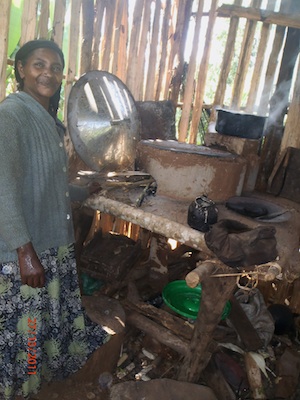Photo Gallery
 Kafa is the birthplace of wild coffee, Coffea arabica, where it has been consumed for more than 1,000 年. There are now close to 5,000 wild varieties of coffee in this biodiversity hotspot. A unique coffee culture is deeply ingrained in the Ethiopian economy and history. This culture is a key element of the participatory forest management scheme created in the Kafa Biosphere Reserve to avoid deforestation and boost economic development.
Kafa is the birthplace of wild coffee, Coffea arabica, where it has been consumed for more than 1,000 年. There are now close to 5,000 wild varieties of coffee in this biodiversity hotspot. A unique coffee culture is deeply ingrained in the Ethiopian economy and history. This culture is a key element of the participatory forest management scheme created in the Kafa Biosphere Reserve to avoid deforestation and boost economic development.
NABU (The German Nature and Biodiversity Conservation Union) and its partners have worked towards the preservation of these forests obtaining the establishment of the UNESCO Kafa Biosphere Reserve in June 2010 and implementing the project: “Climate Protection and Preservation of Primary Forests – A Management Model using the Wild Coffee Forests in Ethiopia as an Example“.
プロジェクトでは、生産と流通を実現し 11200 エネルギー省との共同の努力にもかかわらず住民にストーブ省エネ. 70 失業者の若者が組織され、訓練され、装備に配備された 11 生産と 25 サテライトサイト.
The dependency on biomass energy: a driving force for deforestation
Only 40 数年前に, いくつかの 40% of the Ethiopian land surface was occupied by forests. 今日, less than 3% remains, largely in the Kafa coffee biosphere reserve, which still boasts large areas of mountainous afromontane cloud forest. The forest ecosystem makes an important contribution to the livelihoods of people in the area. It provides wild coffee, valuable spices and honey from wild bees. It also contains some 25 million tons carbon in above-ground biomass. いくつかの 600,000 tons of carbon could be removed from the atmosphere annually through natural forest growth – if the forest remains intact. But it is endangered due to clear-cutting for smallholder agriculture and industrial coffee and tea plantations, and the intensive use of biomass.
エチオピアは、現在にも対応 96 そのエネルギー必要量の割合は、バイオマスを用いた. 多くの世帯が木を切断することによって、その需要を満たすため、この事実のために利用できる天然林/森林や低木地を形成. この状況は、森林破壊のための駆動力の一つとして挙げられている. Kafaの国の人々の他の部分と同様に、主に火災のために木材製品を使用する. 薪は近くの森林から来ている. その上に, バイオマス燃料は、主に非効率的に使用され. これは、世帯収入と時間の予算との直接的な関係を持っている. より非効率的に木材が女性や子どもたちが薪の収集に費やす多くの時間を使用されている.
There is no electric power plant in the Biosphere Reserve. Electricity is supplied only to a few areas of the reserve by an external hydro-power plant.
Energy-efficient stoves and other renewable energy sources
Among the activities carried out by NABU’s Climate and Forest Project to mitigate the impact of meeting energy requirement using biomass, there are two main lines of action: promotion of community plantations with fast-growing tree species as fuel wood and introduction of efficient wood-burning stoves.
In this last case, the target of the project is to introduce energy-saving stoves to the communities in Kafa Biosphere Reserve. 11200 stoves were distributed until September 2012. The plan says that 10000 stoves will be distributed to households with high wood consumption by September 2012. これらのストーブの新しい技術は半分に調理するために必要な木材の量を低減するだけでなく, それはまた、森林を保存する, ユーザーのための時間と少ない煙と火を生成. The stoves are therefore a source of great relief to the people and the forest and have been very well received.
NABUは、水のためにKafaゾーン部門と密接に協力しているストーブを生産し、配布するには, 鉱山エネルギー. この協力の一環として 70 若年失業者は、ストーブの生産者としての訓練を受け、それらの生産事業を開始するためにサポートされていました.
In collaboration with GLEN (Global Education Network of Young Europeans) a study has been conducted on alternative energy sources where coffee husk briquets, バイオガスと太陽は等しく関連として登場.
Annually, in the area of biosphere reserve, 約 100 t of coffee husk is produced. This represents an ideal material for briquetting. But not only the coffee husk: dry leftovers from other crops processing (e.g. maize, sorghum etc.) can be used as well. Another source is biogas production, based on two big potential sources: cattle dung and coffee pulp.
The Kafa Water, Mining and Energy Department has started to implement some renewable energy programs in its “5 years strategic plan” – starting from 2011. 450 PV solar panels were distributed until September 2012.
Lessons learned and potential replicability
The acceptance of wood-saving stoves is very high and they are easily adapted by users. Within this context, local communication and education are essential. The importance of the training programme for young people to help them expand their own knowledge of climate and forest protection is recognised. In turn, they can share this knowledge and raise the awareness of other members of their communities.
With regard to energy, solar power has a high potential and there are multiple benefits of using solar energy in the area. But before installing new panels it is necessary to prepare and train technical staff that will work in the zone.
The successful results of this project may have a significant impact on other areas of the region with similar characteristics and needs. This would be the case of Yayu Biosphere Reserve, also in Ethiopia, and of other similar areas, like the Ituri region in the Democratic Republic of Congo.

















